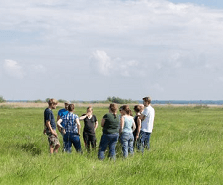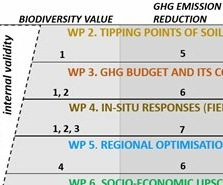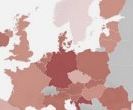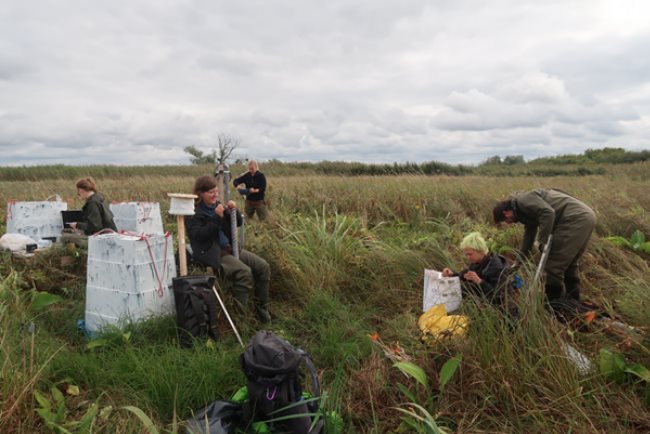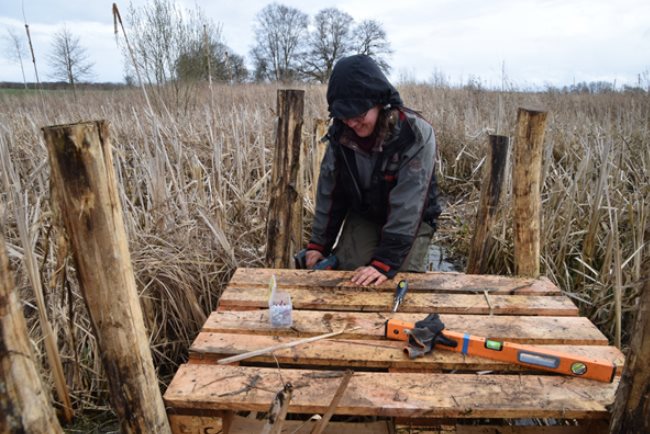PRINCESS
Peatland Rewetting In Nitrogen-Contaminated Environments: Synergies and trade-offs between biodiversity, climate, water quality and Society
Background
Europe faces three major environmental challenges: greenhouse gas (GHG) emissions, nitrogen (N) pollution, and biodiversity loss. Peatlands can play a vital role in addressing these challenges. Drained peatlands in the EU emit ~200 Mt CO2eq a-1 (approx. 5% of total EU emissions), mainly from conventional agriculture on drained peat soils (144 Mt CO2eq a-1). The latter make up only 2.5% of the total agricultural area but produce 25% of the total agricultural GHG emissions in the EU (incl. methane from the digestive process of ruminant farm animals and nitrous oxide from fertilization), with an even larger contribution in peatland-rich countries, e.g. Finland (62%), Poland (42%), and Germany (37%, based on NIR 2019 data).
Drained, agriculturally used peatlands in the EU are also an annual source of 1-5 Mt of nitrate (NO3) (own estimates based on NIR 2019) due to peat mineralization, the decomposition of organic matter in soil which releases nitrogen and other inorganic compounds. Mineralization also has substantial impact on ground and surface water quality, drinking water provision, and biodiversity. Typical peatland biodiversity, in particular that of groundwater-fed fens in temperate Europe, has been devastated by drainage. Consequently, all relevant EU policy objectives include rewetting of drained peatlands as an essential ecosystem-based solution to avoid peatland GHG emissions, reinstall carbon sequestration, reduce nitrogen mineralization, enhance nitrogen removal, and/or restore peatland-specific biodiversity.
Project Goals & Content
PRINCESS is the first project to categorise and evaluate the effects of alternative land use options after peatland rewetting on key EU environmental policies: (1) as a measure to halt biodiversity loss, (2) as a nature-based solution for mitigating and adapting to climate change, and (3) as a management tool to reduce nitrate release and thus eutrophication. PRINCESS investigated the interaction of two main important global change drivers and attempted to take advantage of the coupling between the C and N cycles to maximise benefits from rewetting peatlands.
Our focus on the interactions of peatland rewetting with N loads is due to the lack of knowledge on the overall behaviour of N after peatland rewetting, compared to the relatively well-studied behaviour of phosphorous (P) in rewetted peatlands. In an integrated and novel approach, PRINCESS examines the direct and indirect consequences of nitrogen loads on biodiversity, GHG emission, nitrate release, and biomass yield of rewetted peatlands. PRINCESS focuses on biodiversity of plants, microbes and selected mire-specific fauna, takes a functional perspective, and assesses above- and below-ground productivity. While evaluating landscape-scale solutions for key environmental problems, particular attention is paid to synergies and trade-offs between climate and biodiversity goals and to tipping points indicating when switching from one land use option to another would shift the optimum between policy objectives.
To achieve these objectives, PRINCESS will
- focus on the peatlands which are the largest sources of GHG and affected most by nitrogen loads, i.e. temperate fens. Results, however, are relevant across drained-and-to-be-rewetted peatlands in the temperate and boreal zones.
- bring together complementary skills from six peatland-rich countries, including those with little (FI, NO, PL) and strong peatland degradation and N loading (AT, BE, DE), and the latter is a front-runner in rewetting and paludicultures
- analyse crucial processes under highly controlled conditions in the laboratory and in mesocosms, test them under more realistic conditions in the field, and model and upscale them to catchment and EU scale
- use these different scales of study to maximize internal and external validity through sound interpretation of causal effects and their relevance
- apply the most advanced techniques and methods from biogeochemistry, microbial ecology, plant ecology, socioeconomic modeling across scales, using measurable and quantifiable indicators.
PRINCESS will provide vital scientific information for agricultural land use policies for peatlands in the EU by evaluating which land use option after rewetting complies best - under high nitrogen loads - with key policy objectives such as healthy ecosystems, climate change mitigation and adaptation, clean water, fair income to farmers, or, taken together, a greener and more sustainable Europe.
Details
Field workshops
Field workshop on paludiculture
Lelkendorf, 08.09.2023
Field workshop on cropping paludiculture with cattail
Lelkendorf (Germany), 03.09.2021
Field workshop with foresters and other stakeholders in Poland
22.09.2021
Field workshop about wet meadows and heat generation from paludiculture biomass
Neukalen (Germany), 15.10.2021
Conferences
Society of Wetland Scientists (SWS) Conference
Poland, 24.-26.06.2024 Link
Power to the peatlands,
Antwerp, 19.-21.09.2023
Conference declaration (facilitated by PRINCESS)
Policy briefs
Information paper on paludiculture and biodiversity (2024)
Drained peat soils in Austria – Multiple benefits from rewetting (2025)
PRINCESS Fieldwork Playlist
“Without music to decorate it, time is just a bunch of boring production deadlines or dates by which bills must be paid.” Frank Zappa
That's why we ended up enhancing our long drives to the field sites of the PRINCESS project with some music. So get into your waders, hammer some boardwalks, take some soil samples, and dive into the peat with us!
Here you can find our PRINCESS fieldwork playlist: https://www.youtube.com/playlist?list=PLGa_jgnIxNVEk5nYcMlu7LrIM9Nte709n
Please be aware of privacy implications using Youtube. More information Google Privacy.
Social Media
Follow the Greifswald Mire Centre on...
...to read more about these and other events!
Peer-review publications
Martens HR, Laage K, Eickmanns M, Drexler A, Heinsohn V, Wegner N, Muster C, Diekmann M, Seeber E, Kreyling J, Michalik P, Tanneberger F (2023) Paludiculture can support biodiversity conservation in rewetted fen peatlands. Scientific Reports 13:18091. https://doi.org/10.1038/s41598-023-44481-0
Gios, E., Verbruggen, E., Audet, J. et al. Unraveling microbial processes involved in carbon and nitrogen cycling and greenhouse gas emissions in rewetted peatlands by molecular biology. Biogeochemistry 167, 609–629 (2024). https://doi.org/10.1007/s10533-024-01122-6
Holzknecht, A., Land, M., Dessureault-Rompré, J. et al. Effects of converting cropland to grassland on greenhouse gas emissions from peat and organic-rich soils in temperate and boreal climates: a systematic review. Environ Evid 14, 1 (2025). https://doi.org/10.1186/s13750-024-00354-1
Hanna Kekkonen, Aura Salmivaara, Henri Honkanen, Sanna Saarnio, Aleksi Lehtonen, Mikko Peltoniemi, Hannu Ojanen, Kristiina Lång
Explorative analysis of depth-to-water index in identifying rewettable agricultural peat soils. Journal of Environmental Management, Volume 383, May 2025, 125443.
Baur, P. A., Maier, A., Buchsteiner, C., Zechmeister, T., Glatzel, S. (2024) Consequences of intense drought on CO2 and CH4 fluxes of the reed ecosystem at Lake Neusiedl. Environmental Research 262: 119907. https://doi.org/10.1016/j.envres.2024.119907
Temmink RJM, Lång K, Vroom R, Leifeld J, Fritz C, Zeug W, Thrän D, Kleinspehn C, Gaudig G, Neubert J, Kreyling J, Rhymes JM, Evans CD, Kotowski W, Nordt A, Tanneberger F (2026) Agriculture on wet peatlands: the sustainability potential of paludiculture. Agricultural Systems 231. https://doi.org/10.1016/j.agsy.2025.104561
Kreyling J, Zeterberg K, Aggenbach C, Kollmann J, Kotowski W, Kozub L, Laage K, Scheel P, Schmidt R, Seeber E, van Diggelen R, Zaborowska A, Tanneberger F (2025) Paludiculture maintains the peat formation potential in rewetted temperate fens. Agronomy for Sustainable Development 45, 67. https://doi.org/10.1007/s13593-025-01062-x
van Giersbergen Q, Barthelmes A, Couwenberg J, Lång K, Martin N, Tegetmeyer C, Fritz C, Tanneberger F (2025) Identifying hotspots of greenhouse gas emissions from drained peatlands in the European Union. Nature Communications 16:10825. https://doi.org/10.1038/s41467-025-65841-6
Hobrecht K, Tanneberger F & Metz J (2025). Identifying risk factors for the rare, endangered fen orchid Liparis loeselii in NE Germany with a fresh approach. Basic and Applied Ecology 88:72-82. https://doi.org/10.1016/j.baae.2025.09.001
Completed BSc theses
2022: Nele Wegner „Der Einfluss der Landnutzungsintensität auf die Spinnenfauna in wiedervernässten Niedermooren Nordostdeutschlands“
2021: Marcus Eickmanns „Vergleichende Untersuchung der Brutvögel wiedervernässter Niedermoorflächen unterschiedlicher Nutzungsintensität im Peenetal (Mecklenburg-Vorpommern)“
Completed MSc theses
2024: Katharina Zeterberg “The accumulation of organic matter in rewetted fens in Central Europe: A two year comparison of belowground biomass production and decomposition rates“
2022: Katharina Laage “Vegetation and site conditions of rewetted fens in Central Europe. The effect of different paludiculture options”
2022: Quint van Giersbergen (with Wageningen University, the Netherlands; co-supervised by Prof. K. Lang, LUKE, Finland) “Identifying greenhouse gas emission hotspots for peatlands in the European Union”
2022: Thomas Westhoff (with Wageningen University, the Netherlands; co-supervised by Prof. K. Lang, LUKE, Finland) “Pathways for Peatlands. Towards the achievement of the 2030 & 2050 reduction goals in Dutch peatlands”*
2022: Vincent Heinsohn “Assessment of Ground Beetle Communities (Coleoptera: Carabidae) on Rewetted Fen Peatlands with Different Land Use in North-Eastern Germany”
2022: Hanna Martens (with University of Bremen) „How do we Assess Biodiversity in Paludiculture Sites? Results from a Multi-Taxon Study in Northeastern Germany”
2023: Patrick Scheel (with TU Munich) “Assessment of aboveground and belowground biomass decomposition in natural, drained, and rewetted fens in Central Europe”
2023: Rune Schmidt (with University of Nijmegen, the Netherlands/University of Duisburg) „The trajectory of above- and below-ground biomass production of rewetted fens compared to drained and natural fens in Central Europe”
* Winner of the Hissink Award issued in November 2022 by the Dutch Soil Science Association (NBV) and Winner of the Folkert Hellinga MSc Award issued in September 2023 by the Network Land & Water for the most leading WUR MSc thesis in the broad field of (applied) environmental sciences









